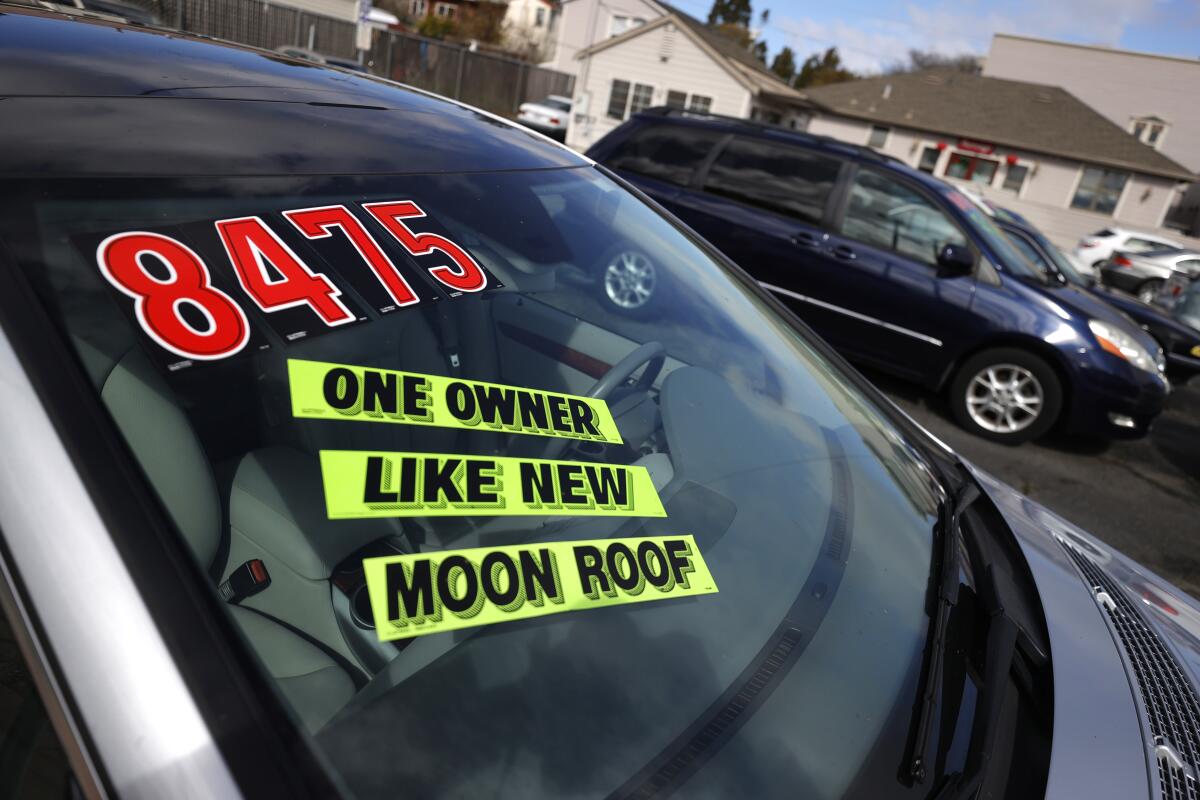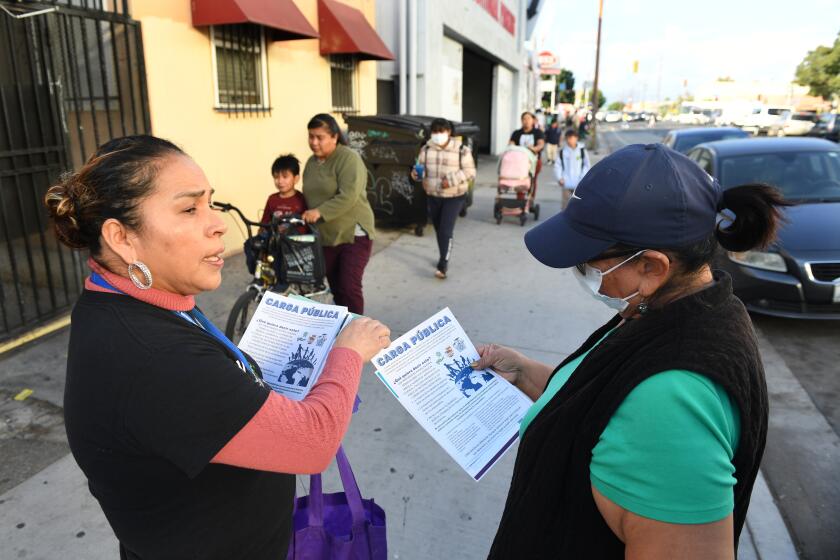Amid inflation worries, Fed signals an earlier increase in interest rates

- Share via
WASHINGTON — The Federal Reserve signaled Wednesday that it would likely nudge up interest rates earlier than previously expected in response to sizzling economic growth and a spike in prices that has sparked inflation fears.
Fed officials, after their two-day meeting, left the central bank’s main interest rate near zero and said it would continue to make massive purchases of Treasury and mortgage bonds to support financial conditions and the recovery.
But policymakers acknowledged the accelerated economic growth — likely to be the fastest in decades — and the recent jump in inflation. And their updated economic projections indicated that significantly more Fed officials now see a rate hike coming next year or in 2023. In March, most Fed officials expected no rate change through 2023.
Stocks fell after the Fed announcement, with the Dow closing down 266 points.
The Fed’s statement described the higher inflation as “largely reflecting transitory factors.” And many private economists agree that the recent surge in prices for many goods and services is a temporary result of a pandemic-stifled economy suddenly free to go full-throttle.
“The process of reopening the economy is unprecedented,” Fed Chair Jerome H. Powell said at a virtual news conference Wednesday afternoon. “Shifts in demand can be large and rapid, and bottlenecks, hiring difficulties and other constraints could continue to limit how quickly supply can adjust, raising the possibility that inflation could turn out to be higher and more persistent than we expect.”
If inflation should stay high, Powell said, the Fed could always make adjustments in its easy-money policies, including its main lever, interest rates. But historically, central banks have had trouble getting the timing right. And some economists worry that Fed policymakers may be underestimating the danger of the current problem.
“Why is the Fed remaining so accommodative in the face of higher inflation?” said Greg McBride, an analyst at Bankrate.com
Chris Rupkey, chief economist at Fwdbonds, a financial market research firm in New York, said, “This inflation looks as permanent as it is dangerous because higher prices have the ability to curb consumer purchases and shut the economy’s spending right back down in a hurry.”
After decades of almost no inflation, the current surge has unsettled financial markets and spread alarm among some business and political leaders. Democrats in particular worry that Republicans will play on fears of runaway inflation to win control of Congress next year.
Consumer prices jumped 5% in May from a year ago, the fastest pace since August 2008. Producers are paying more for supplies, and many workers in the wake of the COVID-19 pandemic are holding out for better pay, raising the prospect of higher wages adding to inflationary pressures.
“This is the reality. We’re dealing with inflation,” said Diane Swonk, chief economist at Grant Thornton in Chicago. “Most people haven’t seen this kind of inflation, and it’s startling. It’s hot.”
Beyond specific products and sectors, what’s fueling inflation overall is booming pent-up demand. Many consumers have lots of cash and savings to go with it. Others have benefited from massive federal spending and a reopening of economies after many months of pandemic restrictions.
IHS Markit, a leading forecasting firm, predicts the U.S. economy will grow at a blistering annual rate of 11% in the current quarter, slowing only to a rapid 8.5% pace in the final three months of the year.
On top of that, Swonk and other economists worry that a semiconductors shortage, which has disrupted auto production, and other supply bottlenecks pushing up prices could last for more than a few months. With home prices soaring, rents could soon follow. And imports of China-made goods are costing more, too.
“There are just a lot of different things out there that are pushing our costs up and pushing prices up, and therefore inflation,” said Gregory Hayes, chief executive at Raytheon Technologies and a leader at the Business Roundtable, an association of CEOs of major companies.
In their latest projections Wednesday, Fed officials said inflation would hit 3.4% this year, up a full point from their March forecast. Still, most Fed officials continue to believe that inflation will fall back to about their 2% target next year.
In March, most policymakers indicated that the Fed’s benchmark interest rate would likely stay near zero through 2023. But their new projections show that 13 out of 18 Fed members expect some rate hikes occurring by 2023.
And this summer, Powell is expected to lay out a plan for scaling back the Fed’s current monthly program of buying $120 billion of Treasury and mortgage bonds, which has held down long-term rates and supported the housing and stock markets.
Historically, inflation expectations have been a good indicator of where prices are heading. Economist Richard Curtin worries about a dangerous inflationary psychology taking hold.
In his monthly University of Michigan consumer sentiment index, Curtin said record numbers of consumers noted that rising prices were an issue. And importantly, they are by and large accepting them, he said, and that’s made it easier for one company after another to raise prices.
“You can go to almost any restaurant or service, and there are additional fees and costs because of the pandemic,” Curtin said. “I don’t think they’re going to disappear anytime soon.”
Adding to pricing pressures is that more firms are competing for limited supplies — and also workers.
The economy still has about 7.6 million fewer jobs today than before the pandemic, and the unemployment rate was 5.8% in May, well above the 3.5% level in early 2020. Yet many employers are having trouble filling jobs.
There were a record 9.3 million job openings in April, according to government data. More workers are quitting jobs, and many are on the sidelines and appear to be taking longer to look for better-paying work.
“People are no longer attached to their former employers,” said Swonk. “And the fact that [some people] had hazard pay adjusted people’s expectations.”
The Business Roundtable’s Hayes said wage growth was running at 3.5% to 4%, about a point higher than before, in part because of the limited supply of available workers.
“The hope, of course — the hope of the Fed — is that this is transitory,” Hayes said of higher inflation, in a call with reporters Tuesday.
“The question is, how long is transitory? Is it six months, is it 12 months, or have we gotten into what unfortunately would be an inflationary cycle where wage growth follows wage growth which follows wage growth, which means it’s not transitory?”
“We’re starting to see that pressure out there,” he added. “We hope the Fed is right and that the Fed will take whatever is necessary to cut this off before it really does become an inflationary spiral.”
Fed officials are expecting strong job creation to continue and unemployment to fall to 4.5% by year’s end, dropping to the pre-pandemic level of 3.5% in 2023. But Powell noted that there are a lot of uncertainties about the path of the labor market as well as inflation.
“This is an extraordinary, unusual time,” he said. “We really don’t have a template or any experience of a situation like this, and so I think we have to be humble about our ability to understand the data.”
More to Read
Get the L.A. Times Politics newsletter
Deeply reported insights into legislation, politics and policy from Sacramento, Washington and beyond. In your inbox twice per week.
You may occasionally receive promotional content from the Los Angeles Times.










